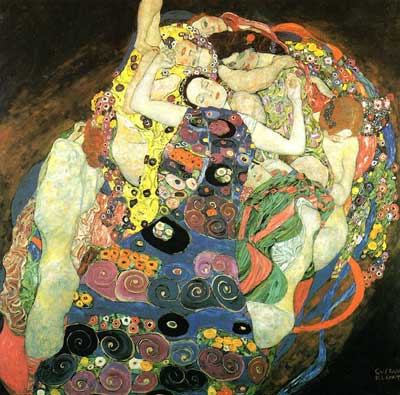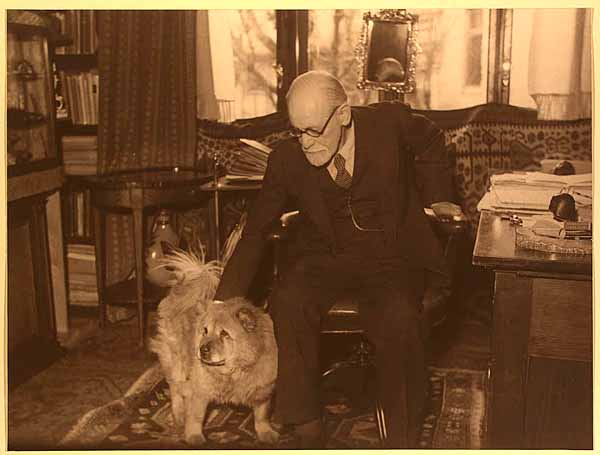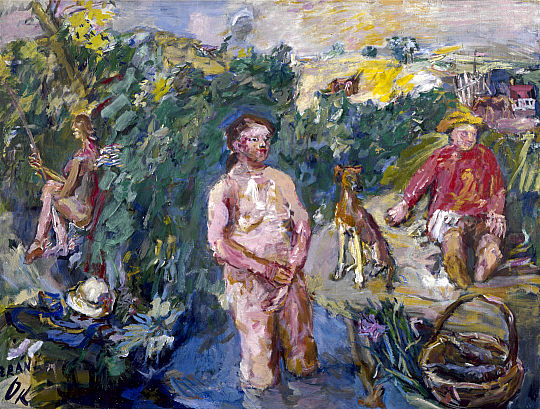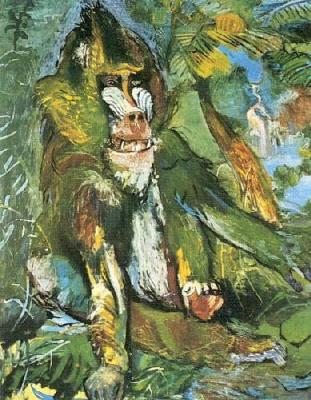In a letter written in 1892 to Wilhelm Fliess, Freud made a remark, ” No neurasthenia or analogous neurosis exists without a disturbance in the sexual function.” “I am pretty well alone here in tackling the neuroses. They regard me rather as a monomaniac, while I have the distinct feeling that I have touched on one of the great secrets of nature,” Freud wrote to Fliess on May 21, 1894 . Indeed, most commentators in the decades to come accepted Freud’s isolation of anxiety neurosis, but its sexual etiology, which Freud consistently made a condition, continued to be challenged. It was the birth of the study of anxiety Neurosos, in all its glory and splendor, affirmed and challenged; it not coincidentally began in Vienna.

Gustav Klimt. The Maiden. 1912. Treichel:Similarly, Freud must have seen at some point the highly erotic, hotly controversial paintings that Viennese artist Gustav Klimdt painted around 1900, Kuspit said. And Freud was undoubtedly influenced by the unfettered sexuality in these paintings, Kuspit suspects, since sexuality and morality were two of Freud’s professional preoccupations. In fact, Kuspit asserted, Viennese art during the first decade of the 20th century was so “toxic with sexuality” that it would have been nearly impossible for Freud to ignore it.
As professor of neuropathology at the University of Vienna for nearly forty years, Freud continued to look beneath the surface of life and to find uncertainty and uneasiness. In his analysis of the tormented “Frau” Emmas and “Fraulein” Elizabeths who passed under his clinical gaze, the illusions and disparities of Vienna could be seen in microcosm. The surface of life, in Freud’s view, counted for little; what lay concealed meant everything.
Degeneracy was everywhere apparent in Hitler’s Vienna, its manifestation identified in anything from the emancipation of women to expressions of Jewish self-hatred. “We are now fully infected by serious popular mental illness, a sort of black plague for degeneration and hysteria,” wrote Max Nordau, a German-speaking Jew from Hungary. “The degenerates babble and stammer instead of talking . . . They draw and paint like children who with useless hands dirty tables and walls. They make music like the yellow people in East Asia. They mix together all artistic genres.”

Schoenberg in folk garb playing cello. 1890's. Treichel:It is also likely that certain Viennese cultural factors influenced him indirectly as well. For instance, the Viennese composer Arthur Schoenberg was responsible, according to Nagel, for “the emancipation of dissonance”—a shocking development in the music world of that time. Although Freud probably did not know Schoenberg personally, Nagel said, Schoenberg’s music reflects a “free association” that also can be found in Freud’s “free association” of ideas. Might the “free association” in Schoenberg’s music have influenced Freud’s concept of “free association”? Nagel implied that it is possible.
Nordau’s hysteria had many echoes. For example, in the influential Gender and Character, Otto Weininger, a young self-loathing Jewish intellectual, took up many of his ideas, writing in a kind of rapture of his contempt for modern art and Freudian psychoanalysis, for science, for the sexual permissiveness of contemporary Viennese society and of his hatred for Zionism. Weininger committed suicide at the age of twenty-three, in a house once lived in by Beethoven. Hitler, an admirer, commented that Weininger was a “good Jew” who had killed himself “on the day when he realised that the Jew lives upon the decay of people”. ( Cowley )
In its most distilled essence , Freud, through both his work with patients and his own self-analysis, Freud came to believe that mental disorders which have no apparent physiological cause are symbolic reactions to psychological shocks, usually of a sexual nature, and that the memories associated with these shocks, although they have been repressed into the unconscious, indirectly affect the content not only of dreams but of conscious activity. It is surely no accident that the discoverer of the unconscious was Viennese, for where else in the world did the glittering surface of a fantastic and illusory Vienna hide so many dark and uncontrollable forces burrowed into the farthest reaches of its psyche.

Treichel:But perhaps the most intriguing question is, Would Freud have become such an intellectual giant if he had not lived in Vienna? Certainly Freud benefited from the liberal atmosphere that prevailed in Vienna during the late 19th century, Gay conceded. Nonetheless, he argued, “We have good evidence that Freud was ambivalent about Vienna,” and Freud still would have become a gargantuan thinker if he had lived in some European city other than Vienna. After all, Munich had its own cultural milieu at that time. So did Dresden. Loewenberg, however, disagreed. One of his reasons is that when Freud lived in Vienna, it contained not only Germanic but Eastern European and Greek influences as well, and that Freud appreciated those influences, he said. “You cannot rip Freud out of Vienna!” he exclaimed. ▪
It was in this Vienna that the impoverished Hitler discovered the political potential of anti-Semitism. One one hand, the city in the late nineteenth-century was a hospitable haven for Jews, whose insecurity was assuaged by the progressive nature of the city’s upper classes who looked with disdain on the vulgarity of anti-semitism. On the other hand, Karl Lueger, the city’s mayor from 1897-1910 , had built his political base on overt and grotesque appeals to Vienna’s lower strata ; people who were vulnerable since education was not a prime value, and whom, in general, took little part in the graces and pleasure of traditional Vienna and could not understand the dynamic of the sweeping modernism they saw as invading their lives. In later years Hitler would praise Lueger for his “correct estimate of the social forces” and astutely remark on Lueger’s political instincts that “political fighting power of the upper classes is quite insignificant.”
“The key to following and understanding it is provided by a knowledge of the petite bourgeoisie. Lueger enriched political science by a great discovery: he transformed democracy, a political orientation that was dying of boredom, into modern demagogy, into the art of fobbing people off with the appearance instead of the reality of the situation.” ( Friederich Austerlitz, 1900 )

Dilkey:On the evening of April 12, 1912, at a dinner party given by Carl Moll, she was introduced to the wildly passionate artist, Oskar Kokoschka. They immediately began a tumultuous love affair, and Kokoschka asked her to marry him a mere three days later. Although they did not marry, their frenzied love affair lasted for three years. It was a difficult and stormy time, as each yearned for different things. Oskar wanted Alma as a wife and the mother of his child, and Alma, after enduring such a strict relationship with Mahler, wanted a love affair with no strings attached. Neither o
�s desires changed over the course of the affair which was a source of anguish for both.The ugly undercurrents could not be suppressed forever. The monster constantly needed to be fed or its masters risked being devoured themselves. It was the flowering of the cult of personality that moved into the vacuum where the will to live had faded and with it a vitality to rule based on broader and more noble concerns. Intelligent men began to see clearly that something was coming to an end and the days of living on charm and pretense were exhausted. Many would have agreed with Karl Kraus that Vienna was an “experimental station” for a world in decline. For each angel that left the lab was also a Frankenstein and a coterie of zombies.
Kraus was editor of “Die Fackel” , a journal founded in 1899 and devoted to an examination of the empire’s decay. The hypocrisy of middle-class society was attacked from all sides, and Kraus saw with bitterness that love had been replaced by sexuality and justice had given way to corruption. The full fledged war between the age of reason and the Romantic age had taken a new twist; the new understandings in psychology, nascent, and misunderstood as they were, were engendering a strident form of romanticism that perverted the old myths and folk legends into a politically charged context that pitted urban and rural and orthodox and liberal into a cauldron of discontent.

On Karl Lueger: His polemical attacks, sometimes extremely drastically formulated, were not directed towards reason but consciously appealed to emotions and instincts. Thus he understood how to use rousing speeches to win over the Viennese population to his cause, consciously invoking stereotypical images of alleged enemies and, in particular, making use of anti-Semitic prejudice. Every set back was reduced to a simple formula: “The Jews are to blame” and stirred up hatred with statements such as: “ We will prevent the oppression of Christians and a new Palestine replacing the ancient Austrian empire of Christians”. In the process he activated the traditional Catholic anti-Semitism directed against “the people who killed God”. He combined it with anti-liberal and anti-capitalist elements and thus addressed the widespread prejudice against “money and stock market Jews”, “press Jews”, “ink Jews”, i.e. Jewish intellectuals and businessmen.
ADDENDUM:
Angela Dilkey on Alma Mahler:As Alma progressed with her composition lessons, she realized that her feelings for Zemlinsky ran deeper than those of a student toward her teacher. They began a tumultuous love affair despite ambiguous feelings on both sides. Zemlinsky never thought he was worthy of so beautiful a young woman and Alma did not think it would be sensible for her to attach herself to a man who was not only ugly but also a Jew. They exchanged many passionate letters, but Alma finally left him for the famous conductor Gustav Mahler.
On December 23, 1901, Alma became engaged to Gustav Mahler, a man twenty years her senior. She had known and respected Mahler’s conducting from afar for several years before they met, yet she went out of her way not to meet him, having heard reports of his exploits with the women of the theater. Throughout the next month, Mahler was able to diffuse several of the character flaws he perceived in Alma. Because she was so beautiful and had grown up in comfort, he was aware of her tendency to be vain and jealous when attention was not paid to her.
In fact, she felt that marrying Gustav would require an exceptional sacrifice on her part because she was too beautiful for him, and because he was a Jew. However, his stature as a prominent musician in society helped suppress these thoughts. By reprimanding her cruel behavior toward Zemlinsky, who was still in love with her, Mahler squelched her jealously…At the time Alma and Gustav were married, Mahler was a conductor at the Vienna Hofoper. He had assumed the position of Artistic Director in October of 1897 after leaving Hamburg.
Mahler’s tenure at the Hofoper was tumultuous from the start. From the initial announcement of his appointment, the anti-Semitic press began their attack. “The Deutsche Zeitung and the Deutsches Volksblatt never stopped attacking Mahler in ways and in terms that later became typical of Nazi anti-Semitism.” Alma was unmoved by these attacks on his Jewish stature because Mahler fell into what she considered “the highest category of human being – the creative artist”.
…Alma was drawn to the power of the fascist dictator and she did not hesitate to vocalize her low opinion of Jews. Her prejudices and the beliefs that she had learned from her “childhood idols Wagner and Nietzsche”83 influenced her political leanings. Between 1930 and 1931 the Nazi party was growing rapidly. Hitler had enthralled millions, and his dangerous power was far reaching. In 1932 Alma and Werfel were in Germany for the last time. “By chance, they caught a glimpse of Hitler and Alma was surprised that such
a small, adolescent looking man had enthralled millions.”
When they returned to Vienna, Alma’s relationship with Werfel became strained. She was pushing him to produce a great work, and she kept a tight reign on him. Wanting him to spend all of his time working, his slow progress was an irritant to her as she believed he was wasting too much of his time. The constant struggling in their relationship wore on Alma, causing her vulnerability for
intelligent men to resurface….
By 1933, Alma could no longer ignore the dangerous political currents that were surfacing. German persecution of the Jews was now out in the open and Werfel’s writings were a prime target. Other outstanding Jews were being publicly criticized, among whom were
Thomas and Heinrich Mann, Franz Kafka, Sigmund Freud, and Albert Einstein. Their writings were symbolically burned to ‘protect’ German people. Artists were also targeted. Paintings by Kokoschka, Nolde, Picasso, and many other artists were being displayed as degenerate art.
No Jew, no matter what his position in society, was safe. Alma had to admit to the danger facing her husband. In April 1934,…Alma’s eternal search for a father figure and male role model led to three marriages and several affairs. Early lessons in anti-Semitic thinking resulted in her frequent stinging comments about Jews. However, in her actions, Alma never hurt a Jewish person simply because of his faith. Her marriages to Mahler and Werfel reveal the ambiguity of her feelings. She overlooked their Judaism because of their enormous creative potential. Her support of Werfel in their treacherous flight from Vienna demonstrated her love for him. During her lifetime, Alma saw her beloved Vienna rise to the…





 COMMENTS
COMMENTS